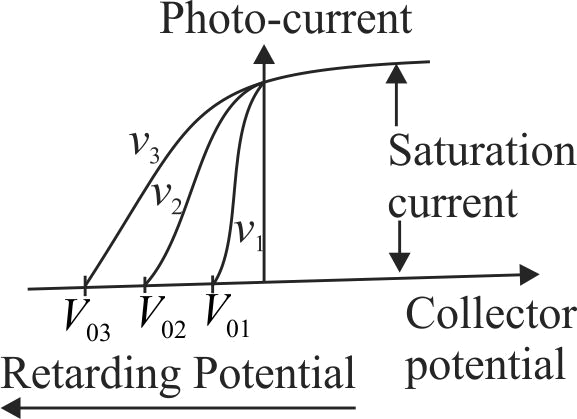357631
Light rays of wavelengths \(6000 \mathop A^{~~\circ} \) and of photon intensity \(39.6\,watts{\rm{/}}{m^2}\) is incident on a metal surface. If only one percent of photons incident on the surface emit photo electrons, then the number of electrons emitted per second per unit area from the surface will be
[Planks constant \( = 6.64 \times {10^{ - 34}}\;J - s\); Velocity of light \( = 3 \times {10^8}\;m{s^{ - 1}}\)]
357632 A metal of work function \(4\,eV\) is exposed to a radiation of wavelength \(140 \times {10^{ - 9}}\;m\). Then the stopping potential required is \(\left( {h = 6.63 \times {{10}^{ - 34}}\;Js} \right.\) and \(c = 3 \times {10^8}\;m{\rm{/}}\left. s \right)\)
357635 Silver has a work function of \(4.7eV\). When ultraviolet light of wavelength \(100\;nm\) is incident on it a potential of \(7.7\;V\) is required to stop the photoelectrons from reaching the collector plate. How much potential will be required to stop photoelectrons, when light of wavelength \(200\, nm\) is incident on it?
357631
Light rays of wavelengths \(6000 \mathop A^{~~\circ} \) and of photon intensity \(39.6\,watts{\rm{/}}{m^2}\) is incident on a metal surface. If only one percent of photons incident on the surface emit photo electrons, then the number of electrons emitted per second per unit area from the surface will be
[Planks constant \( = 6.64 \times {10^{ - 34}}\;J - s\); Velocity of light \( = 3 \times {10^8}\;m{s^{ - 1}}\)]
357632 A metal of work function \(4\,eV\) is exposed to a radiation of wavelength \(140 \times {10^{ - 9}}\;m\). Then the stopping potential required is \(\left( {h = 6.63 \times {{10}^{ - 34}}\;Js} \right.\) and \(c = 3 \times {10^8}\;m{\rm{/}}\left. s \right)\)
357635 Silver has a work function of \(4.7eV\). When ultraviolet light of wavelength \(100\;nm\) is incident on it a potential of \(7.7\;V\) is required to stop the photoelectrons from reaching the collector plate. How much potential will be required to stop photoelectrons, when light of wavelength \(200\, nm\) is incident on it?
357631
Light rays of wavelengths \(6000 \mathop A^{~~\circ} \) and of photon intensity \(39.6\,watts{\rm{/}}{m^2}\) is incident on a metal surface. If only one percent of photons incident on the surface emit photo electrons, then the number of electrons emitted per second per unit area from the surface will be
[Planks constant \( = 6.64 \times {10^{ - 34}}\;J - s\); Velocity of light \( = 3 \times {10^8}\;m{s^{ - 1}}\)]
357632 A metal of work function \(4\,eV\) is exposed to a radiation of wavelength \(140 \times {10^{ - 9}}\;m\). Then the stopping potential required is \(\left( {h = 6.63 \times {{10}^{ - 34}}\;Js} \right.\) and \(c = 3 \times {10^8}\;m{\rm{/}}\left. s \right)\)
357635 Silver has a work function of \(4.7eV\). When ultraviolet light of wavelength \(100\;nm\) is incident on it a potential of \(7.7\;V\) is required to stop the photoelectrons from reaching the collector plate. How much potential will be required to stop photoelectrons, when light of wavelength \(200\, nm\) is incident on it?
357631
Light rays of wavelengths \(6000 \mathop A^{~~\circ} \) and of photon intensity \(39.6\,watts{\rm{/}}{m^2}\) is incident on a metal surface. If only one percent of photons incident on the surface emit photo electrons, then the number of electrons emitted per second per unit area from the surface will be
[Planks constant \( = 6.64 \times {10^{ - 34}}\;J - s\); Velocity of light \( = 3 \times {10^8}\;m{s^{ - 1}}\)]
357632 A metal of work function \(4\,eV\) is exposed to a radiation of wavelength \(140 \times {10^{ - 9}}\;m\). Then the stopping potential required is \(\left( {h = 6.63 \times {{10}^{ - 34}}\;Js} \right.\) and \(c = 3 \times {10^8}\;m{\rm{/}}\left. s \right)\)
357635 Silver has a work function of \(4.7eV\). When ultraviolet light of wavelength \(100\;nm\) is incident on it a potential of \(7.7\;V\) is required to stop the photoelectrons from reaching the collector plate. How much potential will be required to stop photoelectrons, when light of wavelength \(200\, nm\) is incident on it?
357631
Light rays of wavelengths \(6000 \mathop A^{~~\circ} \) and of photon intensity \(39.6\,watts{\rm{/}}{m^2}\) is incident on a metal surface. If only one percent of photons incident on the surface emit photo electrons, then the number of electrons emitted per second per unit area from the surface will be
[Planks constant \( = 6.64 \times {10^{ - 34}}\;J - s\); Velocity of light \( = 3 \times {10^8}\;m{s^{ - 1}}\)]
357632 A metal of work function \(4\,eV\) is exposed to a radiation of wavelength \(140 \times {10^{ - 9}}\;m\). Then the stopping potential required is \(\left( {h = 6.63 \times {{10}^{ - 34}}\;Js} \right.\) and \(c = 3 \times {10^8}\;m{\rm{/}}\left. s \right)\)
357635 Silver has a work function of \(4.7eV\). When ultraviolet light of wavelength \(100\;nm\) is incident on it a potential of \(7.7\;V\) is required to stop the photoelectrons from reaching the collector plate. How much potential will be required to stop photoelectrons, when light of wavelength \(200\, nm\) is incident on it?

